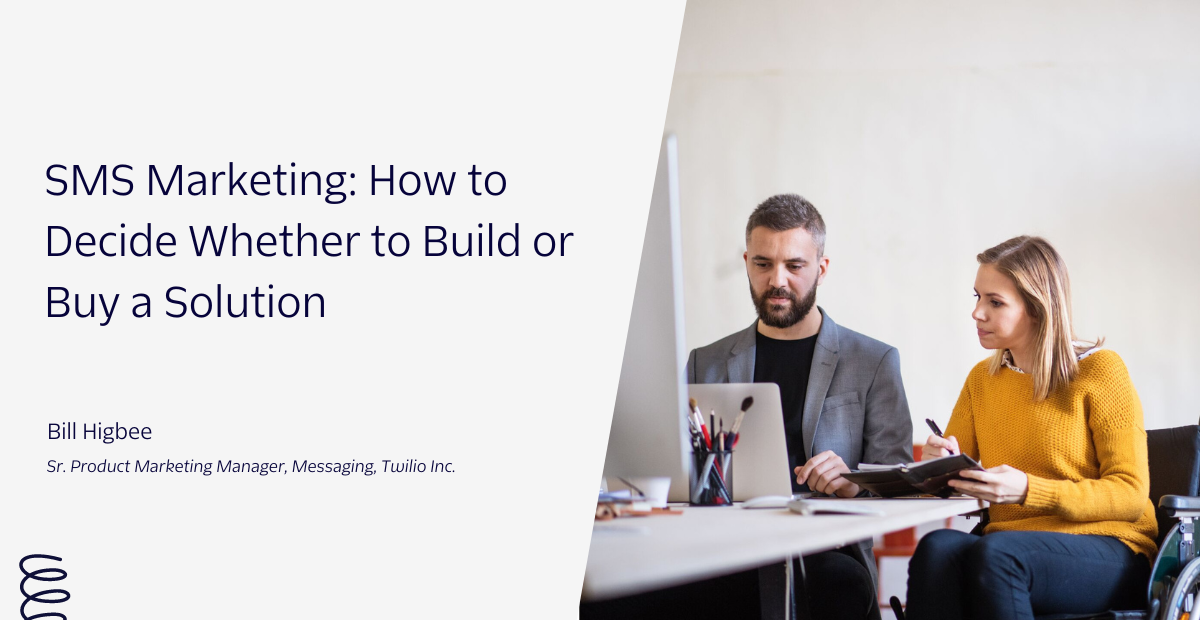SMS Marketing: How to Decide Whether to Build or Buy a Solution
Time to read: 7 minutes

There are a number of reasons why a company might choose to build a customized SMS marketing solution. For example, they may need to integrate with an expanding MarTech stack or support high growth and expansion. But for other companies, out-of-the-box (OOTB) software may provide all they want and need.
Regardless of the final decision, there are some key factors that every business should consider before deciding whether to build or buy an SMS solution. But first, let’s talk about the difference between the two.
Building an SMS marketing solution
For purposes of this blog post, we define ‘Build’ as:
- An internal team of stakeholders is assembled for collaboration. This team generally includes marketing members as well as product managers, engineering leads, and sometimes IT.
- The business requirements are documented, while taking into consideration the immediate needs as well as future desires.
- A provider is selected. An example of a provider would be a CPaaS company that has APIs, software, and analytics tools that can be joined in a multitude of customized ways.
- The internal engineering team joins the parts together, based on the decided business requirements.
Think of it like purchasing a Lego set that has all the right pieces and colors to build your dream restaurant. Some pieces are pre-built to simplify putting it together, such as tables. But the set includes different shapes and sizes of tables because you want the capability to customize to your ultimate vision whether it’s today or in the future.
Additionally, and very importantly, the platform has enough space to expand as your business requires in the future. Perhaps you’ll want to increase the size of the restaurant to seat more customers. Or add an ice cream stand next door along with a boutique and a putt putt golf course. The opportunities are endless.
Buying an out-of-the-box SMS marketing solution
Conversely, a ‘Buy’ solution is an out-of-the-box (ready-to-use) software solution. It will typically meet many of a marketing team’s immediate needs and can be integrated with the most important tools in the company’s MarTech stack.
To continue with the Lego analogy, think of it as purchasing a Lego restaurant that has already been assembled and is glued together so it can’t be taken apart and rebuilt into something else. The outside looks good, but the tables may not be ideally placed to support the maximum number of customers you want.
And unlike the previous example, this Lego set doesn’t allow for expansion, which leaves you with a few options:
- Get rid of the original set and purchase a new one (rip and replace)
- Purchase expensive expansion packs
- Place an ice cream shop and boutique next to your restaurant, but they will not be connected as there is no room.
With those definitions in mind, let’s review some key criteria that may help you decide whether building or buying an SMS solution is right for you.
Key Criteria in Your Build Versus Buy Decision
First and foremost, if your company simply doesn’t want or have the option to use engineering resources to build solutions, that’s a sign that buying is likely right for you.
Additionally, if you are going to build, you need to secure a commitment from engineering resources beyond the up-front ideation phase and implementation. They need to commit to helping you achieve ongoing success, which includes maintenance and future enhancements. If this is not feasible, that’s another sign to buy.
With that in mind, at Twilio, we have experience working with companies who decided to buy an OOTB solution but ran into pitfalls that drove them to eventually build. Some examples include:
- Fragmented teams who want to utilize texting: If your company has multiple departments that desire to use SMS for customer engagement, an out-of-the-box texting solution that has been built specifically for marketing will be limiting.
- Disparate systems that host large quantities of data: The more internal resources that must be communicated with to effectively message your customers, the more likely it is that an OOTB solution won’t suffice.
- Marketing uses multiple communication channels: Pitfalls here include providing a consistent brand experience across all channels and ensuring you are not over-messaging and frustrating customers because the various teams/channels are not connected. A few common marketing channels include texting, email, WhatsApp, Google Business Messages, push notifications, voice, and video.
- High growth: Businesses love to grow quickly. But if an OOTB solution is not capable of supporting that growth, this becomes a major pitfall. Simple examples are the capability to support expansion globally and having high throughput to distribute the necessary volumes of SMS in the future.
Let’s dive into a more exhaustive list of considerations to help you move forward.
More Considerations for Marketing Leaders
Below we highlight more common attributes that marketing leaders consider prior to launching an SMS marketing solution. Think through what is most important for your company’s success and move forward with your journey to implement SMS for marketing.
MarTech Stack
Integrations
Connecting the MarTech stack is necessary to share and receive data from various sources. Information is used to create dynamic segments for targeting and personalization of campaigns. This functionality can expand to support omni-channel communication as well.
Examples of integrations required may include CRMs, data warehouses for storage of SMS, marketing automation tools, customer data platforms (CDP), and more.
The costs associated with integrations must also be investigated and considered.
Future-proof and agility to innovate
In a technology-first world, marketing and the associated platforms are changing constantly. Building with an extensible platform will enable easy integration into future marketing technologies as a company’s needs and desires grow.
When buying a ready-made solution, it can be difficult to innovate as you are reliant on the provider’s roadmap. A simple example could be a marketing team's desire to test MMS, Google Business Messages (GBM), or international expansion with WhatsApp or alphanumeric senders.
Vendor Management
Resource implications
Minimizing vendors to facilitate all customer engagement channels (SMS, email, WhatsApp, Messenger, voice, video, chat, etc.) helps alleviate the resource intensive process of vetting and integrating new solutions. Building with a leading customer engagement platform such as Twilio helps overcome this risk.
Total Cost of Ownership (TCO)
TCO benefits can be obtained from minimizing vendors and achieving economies of scale. Common contributors to added expenses from multiple vendors are add-ons, updates, and upgrades.
Compliance with government and carrier requirements
Government and Carrier compliance requirements vary by country as well as sender type (number type). They are also updated or altered on a fairly regular basis. The implications to ROI can be significant due to filtering of messages and blocking of numbers in entirety.
The bottom line is that your SMS marketing solution provider should provide the resources, processes, and expertise to ensure compliance with regulatory requirements.
Time to solution/market
The time necessary to deploy an SMS marketing solution will be dependent on your business requirements, internal resources available to help, and how extensive the development and/or integrations are.
For smaller marketing teams with minimal integration requirements, an out-of-the-box solution may enable SMS marketing programs to be deployed very quickly.
Conversely, when choosing to build, some marketing teams choose a crawl, walk, run solution that enables testing quickly with a long term roadmap for extended functionality.
Price: Today and in the future
When it comes to building, oftentimes the pricing structure is based on usage whereby you pay a very small fee per every message sent or received. The benefits of this structure are that it includes minimal upfront costs and enables you to test as you grow rather than being locked into contracts.
When buying an OOTB solution, the pricing is typically based on a subscription model (paying per license) and it may also include a usage component. Other considerations are costs for special features such as integrations.
Scalability
Volumes
Marketing leaders should evaluate their future growth targets and ensure the SMS marketing solution can support increases in volumes with reliable delivery and high throughput.
When investigating an OOTB solution, be sure to evaluate costs associated with upgrading to a different package when you have reached this level.
Geolocation: Global reach
Marketing leaders should document their immediate location requirements as well as future growth objectives and then ensure the SMS marketing provider can facilitate expansion into those new regions/countries in the future.
Facilitating expansion includes deliverability, sender types (numbers), channels, security, and support for compliance and global privacy requirements.
Reliability
Uptime
Transparency into uptime and SLAs should be readily available to inquiring marketing leaders.
Deliverability
Deliverability is the percentage of messages that reach the intended recipient and it directly impacts the ROI of SMS marketing.
Maximizing deliverability is dependent on the provider’s infrastructure, carrier relations, and their ability to help marketing teams reduce filtering. The provider should offer support through knowledge transfer as well as transparency into metrics that enable a marketing team to troubleshoot issues and optimize campaigns quickly.
Extent of SMS functionality
Marketing leaders need to be very specific to ensure the solution will meet their needs. Common items to consider include the capability for:
- 2-way conversational texting
- 1-way promotional texting
- Bulk distribution functionality
- MMS functionality
- Message scheduling and delivery according to recipients time zones
- Link shortening with the brand name in the URL
- Link tracking (ability to append tracking parameter to URLs)
- Channel proliferation (e.g. WhatsApp, Facebook Messenger, Google Business Messages, etc)
- Sending on specific types of numbers such as US A2P 10DLC, Toll-free, Short code, etc.
Analytics, tracking and reporting
Marketing leaders need to ensure that the solution provides the ability to effectively view results (data) for optimization of campaigns and reporting on ROI. Examples may include volumes of subscribers, opt-outs, sends, replies, CTR, revenue, conversions/orders, etc.
Move forward with building your SMS marketing strategy today
Regardless if your company typically leans towards ‘building’ or ‘buying,’ we recommend that you meet with a thought leader and trusted partner to help you make an informed decision. Twilio is such a partner. We have 275,000 active customer accounts on the Twilio platform and facilitate 130B+ messages to be sent or received every 12 months. Additionally, our platform is the foundation for some of the leading OOTB SMS marketing providers in the industry and we can make recommendations based on your business needs.
Bill Higbee is a Sr. Product Marketing Manager, Messaging, at Twilio. Bill has 20+ years experience in technical marketing roles spanning API, SaaS, Telecom, and more. When Bill isn’t helping businesses enhance their customer engagement, he’s most likely skiing, golfing, or finding some other way to have fun outdoors. Feel free to reach out to him at whigbee@twilio.com or linkedin.com/in/billhigbee.
Related Posts
Related Resources
Twilio Docs
From APIs to SDKs to sample apps
API reference documentation, SDKs, helper libraries, quickstarts, and tutorials for your language and platform.
Resource Center
The latest ebooks, industry reports, and webinars
Learn from customer engagement experts to improve your own communication.
Ahoy
Twilio's developer community hub
Best practices, code samples, and inspiration to build communications and digital engagement experiences.


